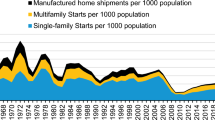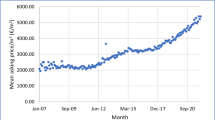Abstract
Purpose of Review
The housing industry has long provided important markets for the higher-value hardwood lumber used in fixtures such as cabinets, flooring, and millwork. These markets have become even more important in the face of the decline in furniture manufacture in the USA. The importance of housing and other construction markets to the US hardwood industry is the focus of the current review.
Recent Findings
The housing crisis that began in 2007 (from a construction data perspective) has had a profound impact on the hardwood industry by reducing demand for many products and hardwood industry employment, metrics that recently have started to recover. For higher-value hardwoods, exports have become a critical market in the face of historically low US housing starts. Industrial markets such as pallets and railway ties, traditionally markets for lower-value products, also have increased in relative importance in recent years.
Summary
While housing starts are expected to eventually return to the long-term trend, an analysis of the current marketplace illustrates the importance of the construction markets to the hardwood industry. Potential new markets for emerging products that can make use of hardwoods also are derived from construction-based sectors, so the overall importance of housing and building construction to the hardwood industry is not likely to wane for the foreseeable future.





Similar content being viewed by others
References
Papers of particular interest, published recently, have been highlighted as: • Of importance
Leamer EE. Housing is the business cycle. National Bureau of Economic Research. 2007; Working Paper 13428. 72 pp.
• Howard JL, McKeever DB. U.S. forest products annual market review and prospects, 2011–2015. USDA For Serv Res Pap FPL-RN-0336, 2015, 11 pp. This paper, in addition to providing commentary and analysis concerning economic conditions for wood products, provides current market share data for all major wood products across all major industries and sectors.
U.S. Census Bureau. Construction spending, historical value put in place. 2016; Retrieved from http://www.census.gov/construction/c30/historical_data.html
Robichaud F, Kozak R, Richelieu A. Wood use in nonresidential construction: a case for communication with architects. For Prod J. 2009;59(1/2):57–65.
Schuler A, Adair C. Demographics, the housing market, and demand for building materials. For Prod J. 2003;53(5):8–17.
Alderman DR, Bumgardner MS, Baumgras JE. An assessment of the red maple resource in the northeastern United States. North J Appl For. 2005;22(3):181–9.
Luppold WG, Bumgardner MS. Forty years of hardwood lumber consumption: 1963 to 2002. For Prod J. 2008;58(5):7–12.
O’Connor J, Kozak R, Gaston C, Fell D. Wood use in nonresidential buildings: opportunities and barriers. For Prod J. 2004;54(3):19–28.
Sinclair SA. Forest products marketing. McGraw-Hill, 1992, 403 pp.
Luppold WG, Bumgardner M, McConnell TE. Impacts of changing hardwood lumber consumption and price on stumpage and sawlog prices in Ohio. For Sci. 2014;60(5):994–9.
• Luppold WG, Bumgardner MS. US hardwood lumber consumption and international trade from 1991 to 2014. Wood Fiber Sci. 2016;48(3):162–70. This paper provides recent and historical estimates of US hardwood lumber consumption by major market segments (appearance-based and industrial) and describes the importance of hardwood trade (net exports) to the US hardwood industry. The importance of the housing crisis to hardwood lumber demand is illustrated.
USDA, Foreign Agricultural Service. Global Agricultural Trade System (GATS) online. 2016; Retrieved from https://apps.fas.usda.gov/gats/default.aspx
Luppold WG, Bumgardner MS. Thirty-nine years of U.S. wood furniture importing: sources and products. Bioresources. 2011;6(4):4895–908.
Luppold WG, Bumgardner MS. Examination of worldwide hardwood lumber production, trade, and apparent consumption: 1995-2013. Wood Fiber Sci. 2015;47(3):283–94.
• Wear DN, Prestemon JP, Foster MO. US forest products in the global economy. J For. 2016;114(4):483–93. This paper shows US industrial roundwood consumption in a global context, discussing different cyclical (e.g., housing) and long-run trends (offshore competition) affecting US production. It is concluded that cyclical improvement in housing will benefit US production but offshoring in some major sectors will prevent the US from returning to the peak production levels of the late 1990s .
Luppold WG and Bumgardner M. The international hardwood lumber market and potential impacts on your bottom line. Pallet Enterprise. 2014; December:20,22,24–5.
U.S. Census Bureau. North American Industrial Classification System. 2016; Retrieved from http://www.census.gov/eos/www/naics/
USDL, Bureau of Labor Statistics. Quarterly census of employment and wages. 2016; Retrieved from http://data.bls.gov/cgi-bin/dsrv?en
Carnes WS, Slifer SD. The atlas of economic indicators. Harper Business, 1991, 232 pp.
U.S. Census Bureau. New residential construction, historical data. 2016; Retrieved from http://www.census.gov/construction/nrc/historical_data/index.html
• Alderman D. Housing and construction. Forest Products Annual Market Review 2015–2016. UNECE/FAO publication ECE/TIM/SP/40; 2016. p. 123–131. This paper is the latest in an annual review of developments in housing and construction markets in Europe, the Russian Federation, and North America. The paper provides recent statistics and outlooks for these markets, which have important implications for wood products markets.
Bumgardner MS, Buehlmann U, Schuler AT, Koenig KM. Impacts of construction markets on firm performance and behaviors in the secondary woodworking industry, 2010–2013. In Groninger JW, Holzmueller EJ, Nielsen CK, Dey DC, editors. Proceedings of the 19th Central Hardwood Forest Conference. USDA For Ser Gen Tech Rep NRS-P-142; 2014. p. 312–321.
Bumgardner M, Buehlmann U, Koenig K. Investment activities in the U.S. secondary woodworking industry. In Kabrick JM, Dey DC, Knapp BO, Larsen DR, Shifley SR, Stelzer HE, editors. Proceedings of the 20th Central Hardwood Forest Conference. USDA For Ser Gen Tech Rep NRS-P-167; 2017. p 184–191.
Buehlmann U, Bumgardner M, Koenig K. Woodworking and housing: positive trends and actions. FDMC. 2016;30(9):52–4,56.
Bumgardner M, Buehlmann U. To what do firms attribute success? An application of attribution theory to the secondary woodworking industry. Wood Fiber Sci. 2015;47(1):44–9.
Esteves BM, Pereira HM. Wood modification by heat treatment: a review. Bioresources. 2009;4(1):370–404.
• Espinoza O, Buehlmann U, Laguarda-Mallo MF. Thermally modified wood: marketing strategies of U.S. producers. Bioresources. 2015;10(4):6942–52. This paper provides results and discussion of depth interviews with manufacturers and distributors of thermally modified wood products. The qualitative nature of the paper provided details of this emerging market, including uses for specific hardwood species .
Leitch MA. Hardness values for thermally modified treated black ash. Wood Fiber Sci. 2009;41(4):440–6.
Hill CAS. Wood modification: an update. Bioresources. 2011;6(2):918–9.
Mallo MFL, Espinoza O. Outlook for cross-laminated timber in the United States. Bioresources. 2014;9(4):7427–43.
Crespell P, Gagnon S. Cross laminated timber: a primer. Special publication 52. FP Innovation, 2010, 24 pp.
Grasser KK. Development of cross laminated timber in the United States of America. Master’s Thesis, University of Tennessee, 2015, 115 pp.
Mohamadzadeh M, Hindman D. Mechanical performance of yellow-poplar cross laminated timber. Report No. CE/VPI-ST-15-13. Virginia Tech, 2015, 29 pp.
Slavid R. Endless stair. Nick Watts Design and the American Hardwood Export Council, 2013, 51 pp.
Mohammad M, Gagnon S, Douglas BK, Podesto L. Introduction to cross laminated timber. Wood Design Focus. 2012;22(2):3–12.
Espinoza O, Buehlmann U, Mallo MFL, Trujillo VR. Identification of research areas to advance the adoption of cross-laminated timber in North America. BioProducts Business. 2016;1(5):60–72.
Wherry G, Buehlmann U. Product life cycle of the manufactured home industry. Bioresources. 2014;9(4):6652–68.
Vogel-Heuser B, Hess D. Industry 4.0 - prerequisites and visions (guest editorial). IEEE Trans Autom Sci Eng. 2016;13(2):411–3.
Gilchrist A. Industry 4.0: the industrial internet of things. Apress, 2016, 250 pp.
Almada-Lobo F. The industry 4.0 revolution and the future of manufacturing execution systems (MES). Journal of Innovation Management (JIM). 2016;3(4):16–21.
Foresight. The future of manufacturing: a new era of opportunity and challenge for the UK project report. The Government Office for Science, London, 2013, 248 pp.
Hardwood Market Report. The changing landscape of hardwood markets and its impact on sawmill production. Hardwood Market Executive. 2016;10(11):1–8.
Geissbauer R, Vedso J, Schrauf S. A strategist's guide to Industry 4.0. strategy+business. 2016;Summer(83):unnumb. Retrieved from http://www.strategy-business.com/article/A-Strategists-Guide-to-Industry-4.0?gko=7c4cf
Thomas RE. Predicting internal yellow-poplar log defect features using surface indicators. Wood Fiber Sci. 2008;40(1):14–22.
Cai Z, Ross RJ. Mechanical properties of wood-based composite materials. In: Wood handbook: wood as an engineering material, 2010 Edition. Forest Products Society, 2011, p. 12–1-12.
Author information
Authors and Affiliations
Corresponding author
Ethics declarations
Conflict of Interest
Drs. Buehlmann, Bumgardner, Alderman have no conflicts of interests to declare.
Human and Animal Rights and Informed Consent
This article does not contain any studies with human or animal subjects performed by any of the authors.
Additional information
This article is part of the Topical Collection on Wood Structure and Function
Rights and permissions
About this article
Cite this article
Buehlmann, U., Bumgardner, M. & Alderman, D. Recent Developments in US Hardwood Lumber Markets and Linkages to Housing Construction. Curr Forestry Rep 3, 213–222 (2017). https://doi.org/10.1007/s40725-017-0059-y
Published:
Issue Date:
DOI: https://doi.org/10.1007/s40725-017-0059-y




